Evidence-Free ‘Lab Leak’ Speculation Boosts Trump’s Xenophobic Approach to Coronavirus
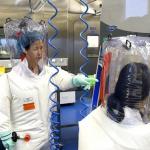
Ever since the outbreak of Covid-19 was first detected in Wuhan, China has been the target of relentless hostile and racist media coverage, depicting the country as a uniquely nefarious source of disease (FAIR.org, 3/24/20, 5/7/20).
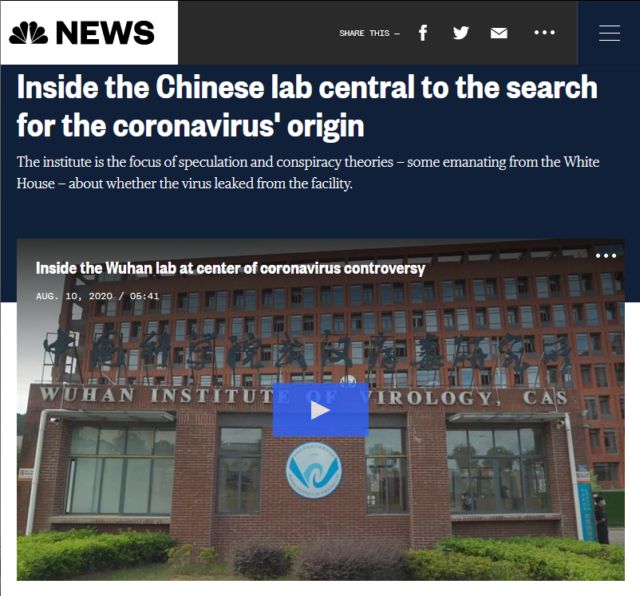
NBC News (8/10/20) was the first foreign news organization to visit the Wuhan Institute of Virology (WIV), which it described as having “become the focus of intense speculation and conspiracy theories” about whether the SARS-CoV-2 coronavirus that causes Covid-19 “leaked from the facility.” While NBC noted that there is “no credible proof to back up claims that the coronavirus was either manufactured at or accidentally leaked from the lab,” the Washington Post’s Josh Rogin (Twitter, 8/10/20) suggested that NBC was “toeing the [Chinese Communist] Party line,” criticism that was amplified by Fox News (8/10/20), which later (8/11/20) cited US officials claiming that “the virus likely originated in the lab.”
While the notion that the novel coronavirus was intentionally or unintentionally leaked from a Wuhan lab has been taken less seriously by corporate media than other criticisms of China’s Covid response (possibly because US officials want to avoid attracting attention to the US’s own biowarfare programs), it has nevertheless been mainstreamed. Ever since Republican Sen. Tom Cotton went on Fox News (2/16/20, 2/18/20) to boost speculation that had been circulating in conservative media and fringe Facebook posts for weeks prior, noting the proximity between the Huanan Seafood Wholesale Market in Wuhan and Wuhan’s “biosafety level four super laboratory,” and decrying “China’s duplicity and dishonesty,” evidence-free speculation about a lab origin has been a media undercurrent that buoys up President Donald Trump’s xenophobic references to the “China virus.”
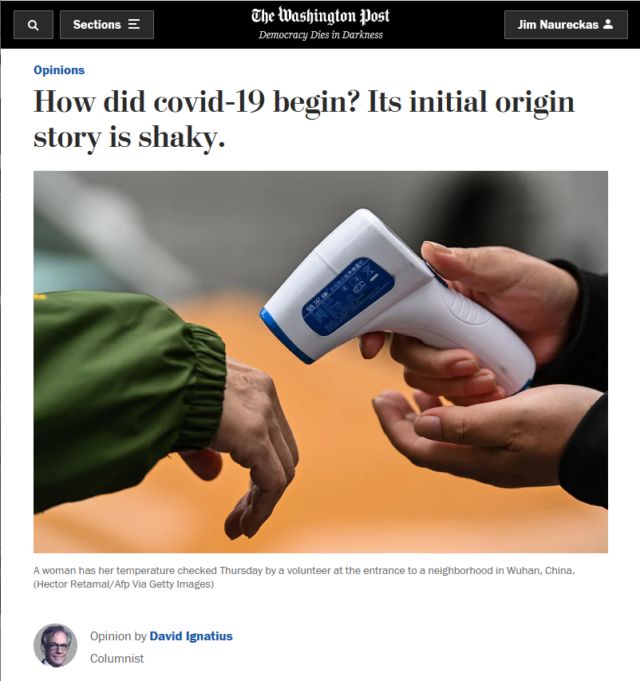
The lab leak theory started gaining an aura of respectability with Washington Post columnist David Ignatius’ “How Did Covid-19 Begin? Its Initial Origin Story Is Shaky” (4/2/20). He argued for the plausibility of a lab accident, writing that “scientists don’t rule out that an accident at a research laboratory in Wuhan” might have “spread a deadly bat virus that had been collected for scientific study.” Ignatius cited Dr. Richard Ebright, a biosecurity expert at Rutgers University who has been a go-to source for several other reports after he spoke publicly about supposed unsafe operating practices at the WIV.
Rogin, Ignatius’ Post colleague, followed up with a piece (4/14/20) about a previously unreleased State Department cable from 2018 that cited “scientists at the WIV laboratory” saying that “the new lab has a serious shortage of appropriately trained technicians and investigators needed to safely operate this high-containment laboratory,” and asking for additional help from US researchers. Rogin managed to quote Xiao Qiang—a National Endowment for Democracy–funded regime change activist and “research scientist” at Berkeley’s “School of Information”—as well as an otherwise unidentified “US official,” but no actual virologists or epidemiologists.
Rogin also depicted Shi Zhengli—the head of the WIV project studying bat coronaviruses—as a reckless scientist taking “unnecessary risks” by linking to an article (Nature, 11/12/15) about experiments that were mostly conducted in the US; the only experiment described in the paper the article critiques (Nature Medicine, 11/9/15) that was actually conducted in Wuhan involved pseudoviruses, which are partial copies of viruses that lack their virulent potential or the ability to reproduce. The Nature article questioned the wisdom of “gain-of-function” (GOF) research in general, not Shi or the WIV’s competence as Rogin implied, as neither of them are mentioned in the article. The safety protocols at the WIV are not only practiced by scientists all over the world, but were also shaped by WIV scientists due to their excellence (NPR, 4/23/20).
Grayzone journalists Max Blumenthal and Ajit Singh (4/20/20) pointed out that Rogin’s column depended on State Department cables that undermined his insinuations throughout the article: US officials emphasized the value of the Wuhan lab’s research to predict and prevent coronavirus outbreaks, rather than safety concerns. Still, Rogin’s column was promoted on Twitter by liberal commentators like MSNBC’s Chris Hayes (4/14/20) and New York‘s Yashar Ali (4/14/20).
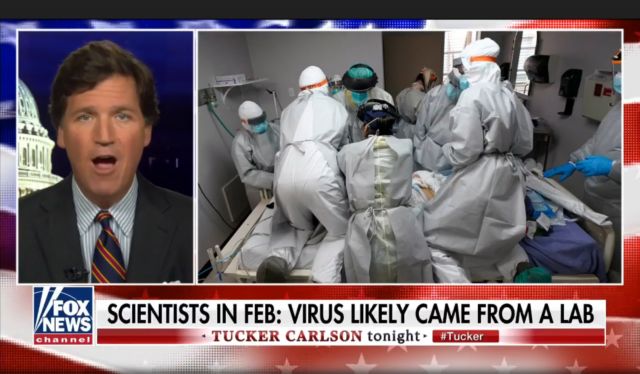
More recently, there was further media buzz over Fox News host Tucker Carlson (9/17/20) defending the credibility of Dr. Yan Li Meng, a discredited defector who makes inflated claims to have worked at the “top coronavirus lab in the world.” She asserted that the Communist Party of China “intentionally” released the coronavirus, and that “the scientific world” is keeping silent because it “works together” with the Chinese government (Forbes, 9/17/20). She co-authored a non-peer-reviewed “study” which made a number of dubious, irrelevant, or false claims published by the Rule of Law Society and the Rule of Law Foundation, which are New York City-based groups Steve Bannon and wanted Chinese billionaire Guo Wengui helped found (National Geographic, 9/18/20).
There are, broadly speaking, two types of lab leak theories: One holds that the virus was created in a lab, the other that the virus evolved naturally in the wild before being collected by a lab. The former theory has an advantage as a scientific hypothesis because it’s falsifiable, meaning that it’s possible to imagine evidence that would prove or disprove it; unfortunately for its proponents, it’s widely viewed by scientists as having been falsified.
Most reports acknowledge the strong scientific consensus around Covid-19 likely originating naturally in wildlife, most likely bats. In February, the Lancet (2/19/20) published an open letter by 27 health researchers from eight countries defending the integrity of Chinese officials and health professionals combating the disease, and strongly condemned “conspiracy theories suggesting that Covid-19 does not have a natural origin.” The open letter also stated that scientific findings to date “overwhelmingly conclude that this coronavirus originated in wildlife, as have so many other emerging pathogens.”
One widely cited study, published in the scientific journal Nature (3/17/20) and written by a team of American, Australian and British researchers, stated that they “do not believe that any type of laboratory-based scenario is plausible,” and that their “analyses clearly show that SARS-CoV-2 is not a laboratory construct or a purposefully manipulated virus.” The authors of the Nature study reached this conclusion because SARS-CoV-2’s adaptations from the original SARS-CoV virus, the pathogen that causes SARS, are too effective for humans to have engineered.
Coronaviruses get their name from the spikes covering the virion’s surface, resembling the sun’s corona. However, the spikes that cover the SARS-CoV-2 virion’s surface bind to the same functional host cell receptor in humans (ACE2) 10 times more tightly than does SARS-CoV. SARS-CoV-2’s second notable adaptation is the acquisition of a polybasic cleavage site (a part of the spike that has to be cleaved before the spike can latch onto a human cell), and SARS-CoV-2’s cleavage sites are made of amino acids that attract furin enzymes, which are essential for infecting lung cells.
Bob Garry (Vice, 3/20/20), an assistant professor of microbiology and immunology at the Tulane University School of Medicine, and coauthor of the Nature study, explained that no computer programs scientists use to model the interactions between the virus’s spikes and ACE2 receptors could predict that SARS-CoV-2 would bind very well, let alone 10 times better—which is evidence in favor of the alterations being selected by natural selection rather than human engineering.
Furthermore, the virus’s genetic makeup isn’t a mishmash of known viruses, which would likely be the case if it were truly human-made, which is why the Nature study’s authors concluded that the “genetic data irrefutably show that SARS-CoV-2 is not derived from any previously used virus backbone.”
Following Rogin’s article, Fox News’ Bret Beier published another op-ed, “Sources Believe Coronavirus Outbreak Originated in Wuhan Lab as Part of China’s Efforts to Compete With US” (4/15/20). Beier claimed that “there is increasing confidence that the Covid-19 outbreak likely originated in a Wuhan laboratory,” coming from “classified and open-source documents” he acknowledged he hadn’t read, relying instead on the accuracy and integrity of anonymous sources.
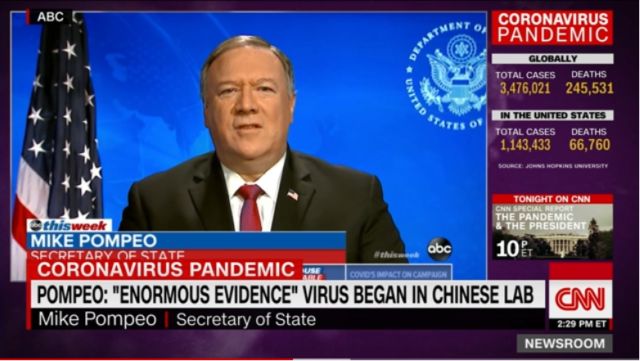
Corporate media then gave a wide platform to Secretary of State Mike Pompeo (ABC News, 5/3/20; CNN, 5/3/20; New York Times, 5/3/20), who has a long record of dishonesty, to promote the lab leak theory. He claimed there is “enormous evidence” the virus originated in a Chinese lab before walking back those pronouncements. Of course, if the US government really did have “enormous evidence” of a lab leak, one can simply ask why it hasn’t already presented a smoking gun.
Other proponents of the lab leak origin claim that the Nature study doesn’t prove what it purports to, because it discounts the possibility of the virus being collected in the wild and studied before somehow being released from a lab. However, this scenario is largely a circular and unfalsifiable argument—because a virus that came from the wild through a lab looks exactly like one that began infecting humans in the wild.
It’s true that there is a troubling history of accidental lab leaks of potential pandemic pathogens. And some of the professionals who authored the Lancet’s open letter and the Nature study have connections to the US government and the bioweapons industry, as much viral research in the US is funded by the Pentagon’s biological arms race (Salon, 4/24/20).
In fact, one compelling reason to think that Covid-19 is not an intentionally leaked bioweapon is that there are plenty of other pathogens that are much more deadly. For example, the Ebola and Marburg viruses have case fatality rates ranging from 24% to 90%, and while we don’t know the true death rate for Covid-19—because it varies widely in different regions—it is much lower than that across the board. If Covid-19 is the result of an intentionally released bioweapon, it would make a lot more sense to select a deadlier pathogen than SARS-CoV-2.
It also doesn’t make any sense for the Chinese government to intentionally release a novel pathogen like SARS-CoV-2 onto its own population in the hopes that it would do even worse damage to its geopolitical rivals. This is simply a fantastical scenario that doesn’t merit further discussion.
US researchers who have worked at the WIV have attested to the safety standards and quality of research there, denied that the WIV is a bioweapons research lab, and explained that the Chinese government issuing new biosafety directives isn’t a sign of concealing a lab breach, but standard practice when dealing with a novel pathogen (Health Feedback, 3/2/20).
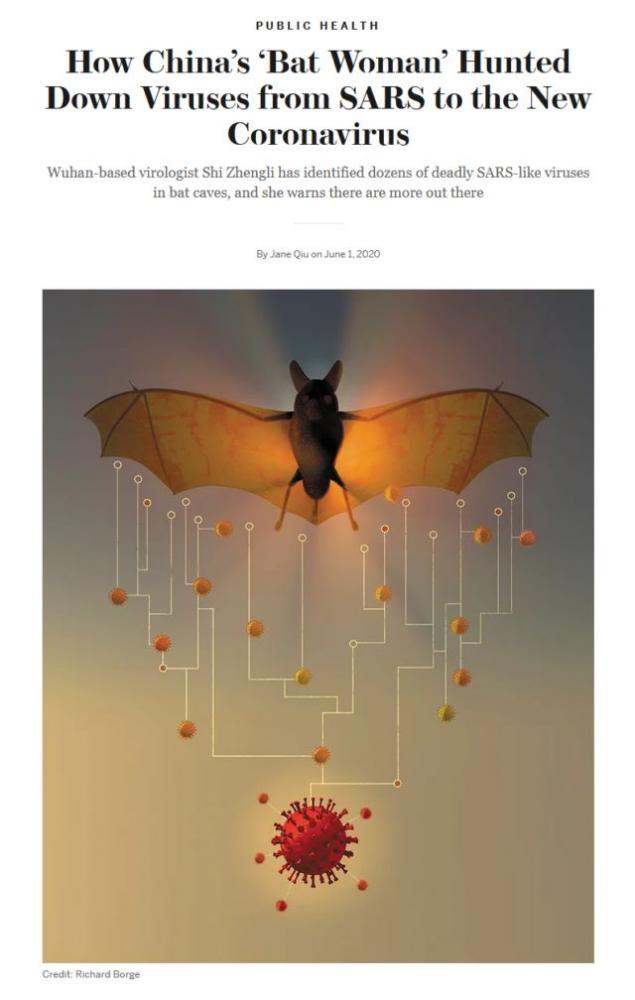
The WIV’s Shi Zhengli, disparaged by Rogin as reckless, is an accomplished virologist whose pioneering research is responsible for giving a headstart in understanding SARS-CoV-2; she attested that none of the bat coronaviruses previously studied at her lab match the new virus’s genetic sequence (Scientific American, 6/1/20). And there’s no reason to think that the WIV was the source of SARS-CoV-2 just because it was already researching bat coronaviruses. Even a virus studied there called RaTG13, which shares 96% of its genome with the new virus, already has huge differences in evolutionary terms, as Vox (4/29/20) noted:
“The level of genome sequence divergence between SARS-CoV-2 and RaTG13 is equivalent to an average of 50 years (and at least 20 years) of evolutionary change,” said Edward Holmes, a professor at the University of Sydney who has published six academic papers this year on the genome and origin of SARS-CoV-2, in a statement. “Hence, SARS-CoV-2 was not derived from RaTG13.”
The WIV lab is a joint collaboration between China and France, and has been certified by officials in both countries, as well as by the International Organization for Standardization. The French government, which has the most knowledge of and experience with the WIV, has stated there is
no factual evidence corroborating the information recently circulating in the United States press that establishes a link between the origins of Covid-19 and the work of the P4 laboratory of Wuhan, China.
Perhaps the strongest argument to be made in favor of the idea of a lab leak derives from reports of the WIV performing animal passage and GOF research (Independent Science News, 6/2/20; Newsweek, 4/27/20). These are experiments designed to create pathogens with pandemic potential by passing a virus through animals (rather than cell culture) to induce faster mutation, or deliberately creating new viruses by cutting and pasting known viruses or via in vitro mutation to prepare for future pandemics.
Numerous labs perform this kind of risky research. The argument that the virus came out of the WIV in particular depends heavily on the city of Wuhan being the site of the original outbreak, because as an urban area like Wuhan is on its face an unlikely place for animal-to-human transmission to have occurred, and the proximity of the WIV and its animal passage experiments, proponents say, is a suspicious coincidence.
But Wuhan has not been proven to be the original location of the global Covid-19 outbreak. That it was the first city to detect an outbreak of Covid-19 does not necessarily mean it originated there.
Many pandemics have disputed origins. The 1918 influenza pandemic was called the “Spanish Flu” because neutral Spain had less censorship than European countries fighting in World War I, and so journalists there were free to write about an outbreak that was emerging across the continent. While the origins of the pandemic are still murky, very few believe the pandemic actually originated in Spain (Conversation, 3/17/20).
French doctors have discovered a case of Covid-19 dated back to December 2019 in someone in who has never traveled to China, and Spanish virologists found traces of SARS-CoV-2 in Barcelona wastewater collected in March 2019—nine months before the virus was detected in China (though these reports don’t necessarily prove that SARS-CoV-2 originated in Europe). Shi Zhengli believes that the crossover from bats to humans occurred outside of Hubei Province (where Wuhan is located), as years of bat virus surveillance there haven’t turned up any bat coronaviruses similar to SARS-CoV-2.
In an exclusive interview with Science Magazine (7/24/20), Shi revealed that over the past 15 years, the Wuhan lab has only isolated and grown in culture three bat coronaviruses related to any that infect humans, and these are related to SARS-CoV, not SARS-CoV-2. The other 2,000+ bat coronaviruses the lab detected (including RaTG13) are merely genetic sequences, and incapable of replicating themselves without being cultured in host cells. This would explain why her lab first learned about the virus when receiving patient samples on December 30, 2019, after the virus was first reported by Dr. Zhang Jixian at Hubei Provincial Hospital on December 27 (FAIR.org, 6/21/20). Shi’s full explanations can be read here.
In the end, the lab leak theory depends on the idea of the virus leaping from animals to humans being improbable–which it is not (Vox, 4/23/20). Due to humans altering three-quarters of terrestrial environments and two-thirds of marine environments, and thereby increasing the nature and frequency of human contact with wildlife, two-thirds of emerging infectious diseases in humans—and almost all recent epidemics like Ebola, MERS, HIV, Zika and H1N1—came from animals, with 70% of those originating in wildlife (LA Times, 4/2/20). This is one reason scientists have been urging climate action and stopping deforestation as ways to prevent new pandemics from emerging (Scientific American, 5/1/18, 6/1/20).
Lab leak proponents primarily depend on making negative arguments that urge us not to discount the possibility of a leak, but not every possibility is probable. Even if it is exceedingly difficult to prove a negative, there’s little reason to entertain a lab origin theory when no actual evidence is presented that the virus originated at any particular lab. Speculation about possibilities does not constitute persuasive evidence that Covid-19 is the result of a lab leak in Wuhan, or anywhere else. While journalists should continue to report on the dangers of bioweapons research and demand more transparency, they should also exercise caution when reporting on coronavirus origin theories that play into New Cold War propaganda against China (FAIR.org, 5/15/20).
Joshua Cho (@JoshC0301) is a writer based in Virginia.
FAIR doesn’t exist without the support of our readers, listeners and activists. To stay independent, we don’t take any advertising or corporate dollars. Your contribution is vital to FAIR taking on the corporate media every day. FAIR is a 501(c)(3) organization, which means your donation to FAIR is tax-deductible.
